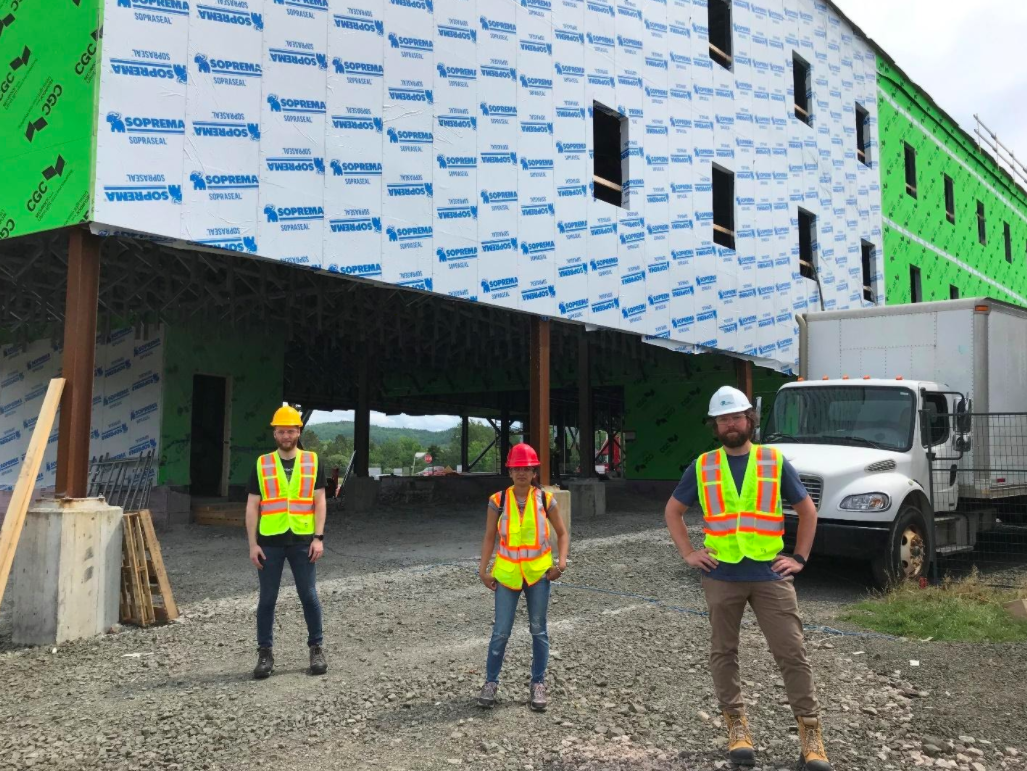Contributed by Tim Webster, Ph.D. and Research Scientist at AGRG.
"An update from the NSCC’s Applied Geomatics Research Group
The pandemic has slowed the progress of AGRG’s research, especially in the area of conducting fieldwork, although the light at the end of the tunnel is now visible and they are beginning to start some field activities. Dr. Tim Webster, who leads the group, is pleased that they did not have to lay anyone off during this time as they all worked from home. Some changes at AGRG include Nathan Crowell who has moved to the Research Specialist position to help guide the group and Dedipya Kodavati takes on the role of Research Associate and joins Kevin McGuigan in that role. Dedipya or “Dee” is a graduate from the Marine Geomatics program at COGS and will lead our multibeam research as well has expertise in laser scanning, processing and is learning hydrodynamic modelling.

Figure 1 Nathan Crowell and Dedipya Kodavati using the Optech Polaris laser scanner to scan the coastline post Hurricane Dorian this spring.
Last year AGRG finished a project through GeoNova for NS Department of Municipal Affairs on how Topo-bathymetric lidar can be used for flood mapping. As part of that study they deployed water level gauges and captured the Hurricane Dorian event both along the coast and up the River John to east and west branch. The report demonstrated how these new lidar data can enhance hydrodynamic (HD) modelling of storm surge events along the coast as well in fluvial and estuarine environments. They flew their Leica Chiroptera 4X topo-bathy lidar sensor at the end of Oct. and captured the River John floodplain and the river channel itself. These data were used for river cross-sections that are the input to 1-D hydrodynamic flood models. The data also proved to be very useful at mapping the pools and shows great potential for mapping fish habitat and fish passage routes. Some other ongoing projects of note include a SSHC (Social Science and Humanities Research Council) project with the Mi’kmaq group Kwilmu’kw Maw-klusuaqn Negotiation Office (KMKO) with Dr. Heather MacLeod-Leslie where we used the topo-bathy lidar to survey a section of the Bras d’Or Lakes to look for submerged archaeological sites. Others included using satellite, aerial imagery and drones to assess the ice conditions for potential aquaculture for CMAR. A project supported through the Atlantic Fisheries Funds used their Chriptera 4X system to construct a seamless elevation model for Pomquet Harbor and build a HD model to determine the best locations to collect oyster seed and place oyster farms in partnership with the Paq’tnkek First Nation. They are also working with the folks at the Whale Sanctuary Project to gather biophysical oceanographic data for the potential site on the eastern shore. We are just beginning a project with the NS Salmon Association to use thermal imagery from drones to map cold water springs in rivers and evaluate the GeoNova and other topographic lidar data for calculating stream metrics (longitudinal profile, slope etc.). We are busy with some laser scanning projects including using a new lidar puck system from Ouster where we are investigating the use of SLAM (Simultaneous Location and Mapping) technology with NS Power. We plan to scan part of the COGS addition to demonstrate how this technology can support BIM (Building Information Modelling) and utilize augmented and virtual reality. The plan is to use a combination of the Optech Polaris laser scanner and the Matterport system which utilizes Structure from Light technology to capture the 3-D environment at different stages of the construction. We will do scans once the plumbing and electrical are roughed in and again after the drywall is in place and one last set once the rooms are finished and painted.

Figure 2 AGRG scanning team (left to right) Jesse Siegal, Dedipya Kodavati, and Nathan Crowell standing in front of the new COGS addition.
Paul Illsley and Bill Livingstone retired from the group this past spring where they were heading up some of the UAV research AGRG does. Bill was able to have a day showing Nathan and Thomas Allen how the DJI Matrice 600 operates with the Velodyne lidar and Headwall hyperspectral sensor. We are anxious to put this equipment to use and are interested in any research project ideas the community may have."
Learn more about AGRG here.
Connect with Tim with the following contact information:
Tim Webster, Ph.D.
Research Scientist, Applied Geomatics Research Group (AGRG)
Centre of Geographic Sciences (COGS), Nova Scotia Community College
Chair, Nova Scotia Branch, Canadian Institute of Geomatics
Adjunct professor, Acadia University & Dalhousie University, Dept. of Earth and Environmental Sciences
Phone: 902-825-5475 Cell: 902-825-7433 Fax: 902-825-5479
e-mail: [email protected]
Website: http://agrg.cogs.nscc.ca/
